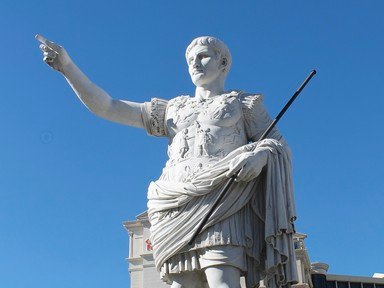Quiz Answer Key and Fun Facts
1. The Battle of Arar was the first major battle in the Gallic wars, in response to the migration of the Helvetii in 58BC, who sought to settle and plunder Roman land. To prevent this, Caesar constructed 19km worth of fortifcations on the forshore of a river to prevent the mass migration. Three parts of the Helvetii forces had crossed the river and Caesar routed the fourth part, to left on his side of the river, killing a great many and driving the rest into the woods. This same army was the force from the Trigurini clan which killed the distiguished consul Lucius Cassius Longinus in which year?
2. The Battle of Bibracte was fought between the Helvetii and six Roman legions, under the command of Gaius Julius Caesar. It was the second major battle of the Gallic Wars. In the initial engagment Caesar's lines easily routed the Helvetii camped on the hill with the execessive use of their pilum. However, the tribes of Boii and Tulingi assisted with 15,000 men who attempted to flank Caesar's legions. How did he respond?
3. In 56BC the Venetii, a seafaring Gallic tribe, revolted against Caesar. Inevitably Caesar had to embark upon both a sea and land campaign against them. For this punitive expedition he built a fleet of galleys to destroy the renowned Venetii navy. However the Romans were no match for their poweful ships. What did Caesar do?
4. The Rebellion of Vercingetorix was Gaul's last attempt to abolish Roman tyranny in Gaul. He learned that the Romans could not be defeated in pitched battles due to their well organised and disciplined fighting formations. What did he do instead?
5. The battle of Alesia was a colossal, final engagement that sealed the fate of Gaul. It was, however, a great achievement for the Gauls in that they set aside ancient rivalries and grudges and united to fight a common enemy.
Despite this, Vercingetorix was defeated. Why?
6. The Battle of Pharsalus in the civil war against Pompey was one of Caesar's finest victories, although he was vastly outnumbered and demoralised from the defeat at Dyrrachium. How did Caesar carve victory out of such a desperate situation?
7. The Battle of Thapus was another episode in the civil war that fought to end Caesar's tyranny. Scipio, the leader of the republican forces, was granted 64 war elephants from Juba the Numidian king. How did Caesar defeat such beasts and win the day?
8. The Battle at Munda was the last battle of the civil war and was nearly a defeat for Caesar. As his troops did the the unthinkable and began to retreat, Caesar with a squadron of cavalry plunged himself into the battle in an attempt to raise morale. This worked and again Caesar won the day. In which region was this battle fought?
9. While in Egypt Caesar wanted to restore Cleopatra to the throne and supported her in a cvil war against her brother. In 47BC he was besieged in Alexandria for how long?
10. In 44BC Caesar was proclaimed dictator for life and planned for another military campaign. In which country?
Source: Author
dying4style
This quiz was reviewed by FunTrivia editor
bloomsby before going online.
Any errors found in FunTrivia content are routinely corrected through our feedback system.


